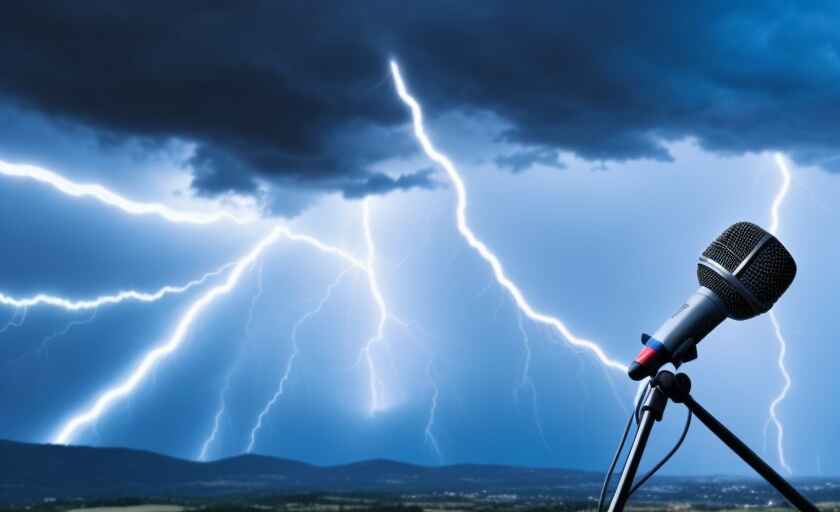Can Severe Storms Affect Wireless Microphones? You might think your trusty microphone is impervious to Mother Nature’s mood swings, but hold onto your soundboard, because it turns out, even our favorite gadgets aren’t safe from her thunderous tantrums!
Curious? Keep reading to uncover the shocking secrets of stormy serenades!
How Do Wireless Microphones Work?

Before we dive into the impact of severe storms, let’s first unravel the mystery behind wireless microphones.
These devices operate on advanced technology, ensuring high-quality audio transmission without the limitations of cords and cables.
Wireless microphones consist of several components working seamlessly together. They include a microphone element to capture sound, a transmitter to convert the audio signal into radio waves, and a receiver to receive and convert these radio waves back into an audio signal.
This signal is then sent to the sound system for amplification and distribution to the audience.
The vulnerability of wireless microphones lies in their dependence on radio frequency (RF) transmission.
External factors, such as interference from other electronic devices and, relevant to our topic, adverse weather conditions, can disrupt this transmission, affecting the audio quality and reliability.
Can Severe Storms Affect Wireless Microphone?

Unpredictable weather can pose challenges for wireless microphones, with the impact varying depending on the specific weather conditions and the frequency in use.
Moisture, in the form of rain, snow, or fog, can introduce signal attenuation, although the extent of this attenuation hinges on both the moisture levels and the chosen frequency range.
Interestingly, lower frequencies tend to weather the rain better than their higher counterparts.
Furthermore, windy conditions can exacerbate the situation by increasing static electricity in the vicinity, potentially affecting wireless transmissions.
While microphones are typically built to withstand the elements, they still require some protection from the cold and damp.
To ensure optimal performance, it’s advisable to allow your equipment to adapt to the new climate conditions before use. You can aid this process by including a few packs of silica gel inside your equipment cases.
Over the years, many professionals have turned to dynamic microphones for their resilience in challenging weather conditions. These microphones have proven to be reliable allies when Mother Nature decides to put on a show.
Gain valuable knowledge on Wireless Microphone through my article: How Does Elevation Wireless Microphone Work? Inner Workings And Can Cell Phones Interfere With Wireless Microphones?
Protective Measures for Wireless Microphones in Severe Weather
When facing the unpredictable nature of severe weather, it’s essential to have a plan in place to protect your valuable wireless microphone equipment.
Here, we’ll explore practical tips and strategies to safeguard your gear, ensuring it remains operational even in the harshest conditions.
Weatherproofing and Waterproof Cases
One of the most effective ways to shield your wireless microphones from the elements is by utilizing weatherproof and waterproof cases.
These specialized enclosures provide a robust barrier against rain, moisture, and even accidental submersion.
Understanding the Use of Weatherproof and Waterproof Cases
Weatherproof cases are designed to resist water, dust, and impact. They typically feature tight-sealing gaskets, pressure relief valves, and durable construction materials.
Waterproof cases, on the other hand, offer a higher level of protection, often with submersion resistance at specific depths.
Recommendations for Products and Brands
When selecting a weatherproof or waterproof case for your wireless microphones, it’s crucial to choose a reputable brand known for producing high-quality protective gear.
Brands like Pelican, Nanuk, and SKB have established themselves as industry leaders, offering a wide range of sizes and configurations to accommodate various microphone models.
Surge Protectors and Lightning Rods
In the face of thunderstorms and lightning, surge protectors and lightning rods play a vital role in safeguarding your equipment from electrical surges and potential damage.
Understanding the Importance of Surge Protectors and Lightning Rods
Surge protectors act as a first line of defense against power surges caused by lightning strikes or electrical faults. They work by diverting excess voltage away from your equipment, preventing costly damage.
Lightning rods, on the other hand, provide a direct path for lightning strikes to safely dissipate into the ground, reducing the risk of electrical discharge.
Installation and Usage Guidance
Proper installation of surge protectors and lightning rods is crucial for their effectiveness. It’s recommended to consult with a professional electrician who is experienced in lightning protection systems.
Additionally, regular inspections and maintenance of these protective measures are essential to ensure they remain in optimal working condition.
Proper Equipment Storage
When severe weather is imminent, taking proactive steps to store your wireless microphones safely can make all the difference in preserving their functionality.
Advantages of Safe Storage Practices
Storing wireless microphones in protective cases during storms offers several benefits. It shields them from direct exposure to rain and moisture, reducing the risk of electrical damage.
Additionally, it provides an extra layer of defense against physical impact or accidental knocks.
Recommendations for Safe Storage
Ensure that your protective cases are designed to fit your specific microphone models snugly.
Place moisture-absorbing desiccant packs inside the cases to help maintain optimal humidity levels. Store the cases in a dry, elevated area away from potential water accumulation points.
Best Practices for Using Wireless Microphones During Storms
Using wireless microphones in adverse weather conditions requires careful planning and strategic execution.
In this section, we’ll outline essential guidelines to ensure the smooth operation of your wireless microphone systems even when faced with challenging weather.
Monitoring Weather Forecasts
Staying informed about the weather is paramount when using wireless microphones outdoors.
Timely updates can make the difference between a successful event and potential equipment damage.
Emphasizing the Importance of Weather Monitoring
Constant vigilance regarding weather conditions is crucial. Keep a close eye on forecasts leading up to the event and monitor for any sudden changes.
Weather conditions can be unpredictable, and being well-prepared allows for timely adjustments to ensure the safety of both equipment and personnel.
Recommended Resources for Real-Time Updates
Utilize reliable weather forecasting platforms and apps that provide real-time updates.
Popular sources like the National Weather Service, Weather.com, and specialized weather apps offer accurate and up-to-date information. Consider subscribing to emergency weather alerts for additional precaution.
Setting Up Sheltered Locations
Selecting the right location for microphone setups during outdoor events is essential in mitigating potential weather-related risks.
Suggesting Ideal Locations for Microphone Setups
Opt for areas that offer natural or constructed shelter from the elements.
Covered stages, gazebos, or pavilions provide excellent protection. If these options aren’t available, consider using pop-up canopies or tents to create a temporary sheltered space.
Creating Sheltered Areas for Equipment Protection
In cases where a covered location isn’t feasible, take proactive measures to shield the equipment.
Use weatherproof covers for microphones and transmitter packs. Ensure that cables are securely routed and protected from rain and moisture.
Emergency Response Plan
Preparing for unexpected weather changes is a critical aspect of using wireless microphones outdoors.
Developing a Contingency Plan
Establish a clear and comprehensive emergency response plan. Designate roles and responsibilities for handling equipment and coordinating event logistics in the event of sudden adverse weather.
Conduct rehearsals of the emergency plan to ensure everyone is familiar with their respective tasks.
Tips for Handling Equipment and Event Logistics During Emergencies
In the event of a sudden storm or adverse weather conditions, prioritize the safety of personnel and equipment.
Securely cover or relocate microphones and equipment to protected areas. If evacuation is necessary, communicate the plan clearly to all involved parties and provide guidance on the designated safe locations.
FAQs About Can Severe Storms Affect Wireless Microphone
What causes interference with wireless microphones?
Wireless microphone interference can result from various sources, including other electronic devices operating on the same frequency, physical obstacles, competing wireless signals, or even radio frequency (RF) interference from nearby sources like cell towers or Wi-Fi routers.
Why does my wireless mic sound bad?
Poor sound quality in wireless microphones can stem from low signal strength, interference, or incompatible frequencies.
Ensure your mic is on a clear channel, the batteries are fresh, and there are no obstructions or electronic devices causing interference.
What are potential hazards for wireless microphone systems?
Wireless mic systems can face hazards such as signal dropout, interference, limited range, and battery failures.
Environmental factors like buildings, weather conditions, and electronic interference sources can also pose risks.
What causes a wireless mic to pop?
Popping sounds often occur due to sudden volume changes or wind hitting the microphone.
Use a windscreen, maintain consistent mic distance, and employ a pop filter to minimize these issues.
Why do wireless mics cut in and out?
Wireless microphones cut in and out due to interference, low battery power, or signal range limitations.
Address these issues by changing frequencies, replacing batteries, or staying within the mic’s operational range.
How can I improve my wireless microphone reception?
To enhance reception, choose appropriate frequencies, minimize obstacles between the transmitter and receiver, elevate antennas, and use high-quality equipment.
Regular maintenance and monitoring for interference also help.
What are the signs of wireless interference?
Signs of interference include dropouts in audio, static, popping noises, erratic signal strength, and reduced microphone range.
Use frequency scans and monitoring tools to identify and mitigate interference sources.
Final Thoughts About Can Severe Storms Affect Wireless Microphone
Severe storms can significantly impact wireless microphone performance. Heavy rainfall and strong winds introduce interference, causing dropouts and signal degradation.
Lightning strikes pose a direct threat, potentially damaging equipment. Humidity and moisture can corrode sensitive components.
Adequate protection measures, like waterproof covers and surge suppressors, are crucial.
Additionally, frequency coordination is essential to avoid clashes with emergency services. In extreme cases, it’s prudent to power down and disconnect equipment until the storm subsides. Ultimately, safeguarding wireless microphones in severe weather ensures uninterrupted communication, preserving the integrity of events and performances. Preparedness is key to maintaining reliable audio transmission in adverse conditions.
